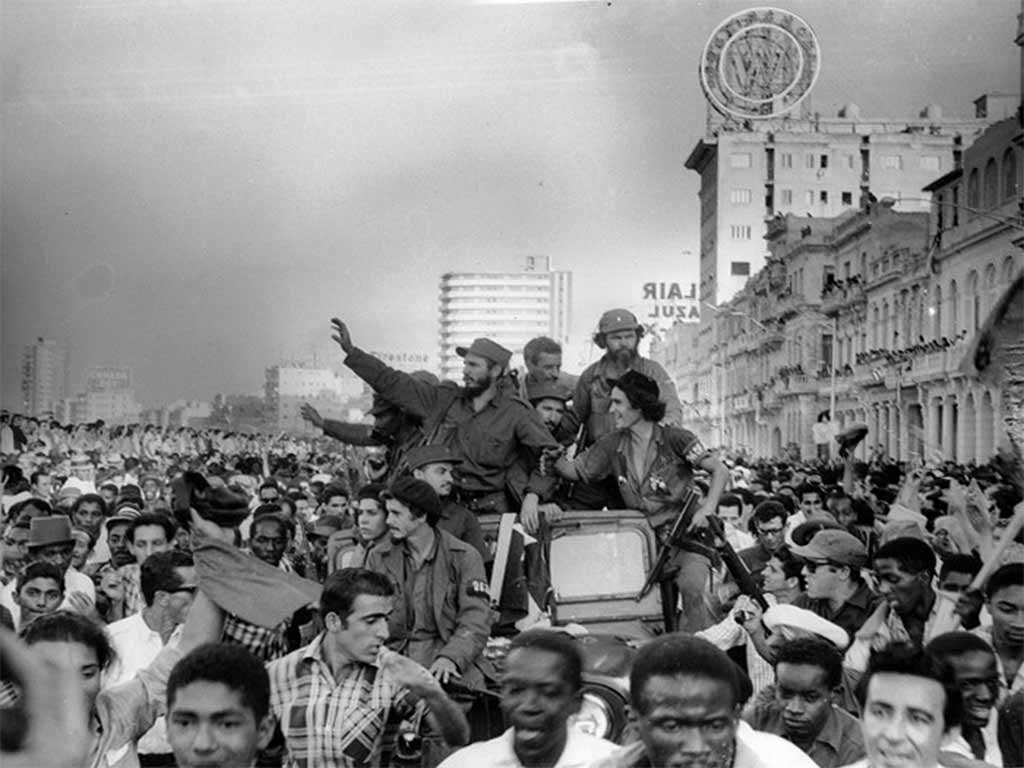m (added stub note) |
No edit summary Tag: Visual edit |
||
| (7 intermediate revisions by 4 users not shown) | |||
| Line 1: | Line 1: | ||
{{ | {{Infobox military conflict | ||
|date = July 26th, 1953 - January 1st, 1959 | |||
|result = [[Cuban Revolutionaries]] Victory | |||
|combatant1 = {{icon|}} [[Cuban Revolutionaries]] | |||
|combatant2 = {{icon|}} [[Cuban Government Armed Forces]] | |||
|type=National liberation revolution | |||
|image= | |||
|place=Cuba}} | |||
The '''Cuban Revolution''' | The '''Cuban Revolution''' was a largely peasant-based national liberation movement in [[Cuba]], waged from July 1953 until New Year's Day 1959 by [[Fidel Castro]]'s [[26th of July Movement]] (M-26-7) against the neocolonial military regime of [[Fulgencio Batista]]. | ||
While the M-26-7 was not an explicitly [[Marxist-Leninist|Marxist–Leninist]] organization, its top leadership was largely dominated by Marxist–Leninists such as [[Raúl Castro]] and [[Che Guevara]], and its earliest announced goals were intentionally kept moderate in order to retain integral support from liberal elements (such as the primarily student-based Revolutionary Directorate) as well as international support from countries hostile to communism. For this reason, Marxist–Leninists consider it to be a national liberation movement moreso than a socialist revolution. In 1961, Fidel Castro announced he was a Marxist–Leninist and that the Cuban Revolution was now a socialist revolution.<ref>https://www.workers.org/2016/11/27970/</ref> | |||
Cuban national history as it was established after the victory of the M-26-7 considers the "Revolution" to be more than just the armed struggle from 1953 to 1959. Instead, the Cuban state refers to the entire period from Cuba's independence from Spanish colonialism until the establishment of socialism as an extended revolutionary process. The "revolution" is used as a term that denotes all of the accomplishments of Cuban socialism since, as well as its proud independence from neocolonialism and US [[imperialism]]. | |||
[[File:Entrada-de-Fidel-a-La-Habana.jpg|thumb|The 26th of July Movement entering Havana on January 8, 1959]] | |||
==References== | |||
{{Reflist}} | |||
[[Category:Cuba]] | |||
Latest revision as of 01:59, 21 July 2023
| Cuban Revolution | |||||||
|---|---|---|---|---|---|---|---|
| |||||||
| Belligerents | |||||||
|
|
| ||||||
The Cuban Revolution was a largely peasant-based national liberation movement in Cuba, waged from July 1953 until New Year's Day 1959 by Fidel Castro's 26th of July Movement (M-26-7) against the neocolonial military regime of Fulgencio Batista.
While the M-26-7 was not an explicitly Marxist–Leninist organization, its top leadership was largely dominated by Marxist–Leninists such as Raúl Castro and Che Guevara, and its earliest announced goals were intentionally kept moderate in order to retain integral support from liberal elements (such as the primarily student-based Revolutionary Directorate) as well as international support from countries hostile to communism. For this reason, Marxist–Leninists consider it to be a national liberation movement moreso than a socialist revolution. In 1961, Fidel Castro announced he was a Marxist–Leninist and that the Cuban Revolution was now a socialist revolution.[1]
Cuban national history as it was established after the victory of the M-26-7 considers the "Revolution" to be more than just the armed struggle from 1953 to 1959. Instead, the Cuban state refers to the entire period from Cuba's independence from Spanish colonialism until the establishment of socialism as an extended revolutionary process. The "revolution" is used as a term that denotes all of the accomplishments of Cuban socialism since, as well as its proud independence from neocolonialism and US imperialism.
